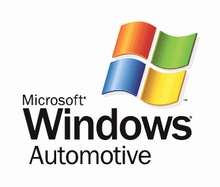Windows Embedded Automotive
Windows Embedded Automotive (formerly Microsoft Auto, Windows CE for Automotive, Windows Automotive, and Windows Mobile for Automotive) was an operating system subfamily of Windows Embedded based on Windows CE for use on computer systems in automobiles. The operating system is developed by Microsoft through the Microsoft Automotive Business Unit that formed in August 1995. The first automotive product built by Microsoft's Automotive Business Unit debuted on December 4, 1998 as the AutoPC, and also includes Ford Sync, Kia Uvo, and Blue&Me. Microsoft's Automotive Business Unit has built both the software platforms used for automotive devices as well as the devices themselves. The current focus is on the software platforms and includes two products, Microsoft Auto and Windows Automotive.
 | |
| Developer | Microsoft |
|---|---|
| OS family | Windows Embedded |
| Source model | Closed source |
| Initial release | December 4, 1998 |
| Latest release | 7 / October 19, 2010 |
| License | Commercial software |
| Official website | www |
| Support status | |
| Windows Automotive 4.2 | Mainstream support ended on July 8, 2008[1] Extended support ended on July 9, 2013[1] |
| Windows Automotive 5.0 | Mainstream support ended on January 11, 2011[2] Extended support ended on January 12, 2016[2] |
| Windows Embedded Automotive 7 | Support ends on March 1, 2021[3] |
History
The Windows Embedded Automotive operating system was originally shipped with the AutoPC that was jointly developed by Microsoft and Clarion. The system was released in December 1998, and referred to the operating system itself as "Auto PC".[4] Microsoft's Auto PC platform was based on Windows CE 2.0, and had been announced in January of that year.[5]
On October 16, 2000, Microsoft officially announced the next version of the platform.[6][7] This version of the operating system was renamed to "Windows CE for Automotive" and had new applications preinstalled like the Microsoft Mobile Explorer.[8]
On October 21, 2002, Microsoft announced that the platform would be renamed to "Windows Automotive".[9] The version added support for development using the .NET Compact Framework.
Windows Automotive 4.2 reached General Availability on June 1, 2003[3] and Windows Automotive 5.0 reached GA on August 8, 2005.[3]
With the release of Ford Sync, Microsoft renamed the platform from "Windows Mobile for Automotive" to "Microsoft Auto".[10]
Microsoft again renamed the operating system as "Windows Embedded Automotive", and updated its version to 7 on October 19, 2010.[11] This is the latest in MS Auto category, and is based on the Windows CE platform.[12]
Windows Embedded Automotive 7 reached GA on March 1, 2011.[3]
In December 2014, Ford announced that the company would be replacing Microsoft Auto with BlackBerry Limited's QNX.[13]
References
- "Microsoft Support Lifecycle for Windows Automotive 4.2". Microsoft. Retrieved February 6, 2015.
- "Microsoft Support Lifecycle for Windows Automotive 5.0". Microsoft. Retrieved February 6, 2015.
- "Product Lifecycles & Support for Windows Embedded Products". Microsoft. Retrieved February 6, 2015.
- "Drivers Keep Hands on Wheel, Eyes on Road, as Auto PC Provides Easy Access to Information and Entertainment". Microsoft. 1998-12-04. Retrieved 2009-05-07.
- "Microsoft Pioneers Interactive Speech Technology". Microsoft. 1998-01-08. Retrieved 2009-05-07.
- "New Microsoft Windows CE for Automotive - Reliable, Flexible and Connected". Microsoft. 2000-10-16. Retrieved 2009-05-07.
- Thurrott, Paul (2000-09-19). "Japanese carmakers sign on to Windows CE". Windows IT Pro. Archived from the original on 2010-01-18. Retrieved 2009-05-07.
- "Microsoft Windows CE for Automotive 3.5 Advances In-Car Computing" (Press release). Microsoft. 5 December 2001. Retrieved 24 April 2011.
- "Microsoft renames embedded automotive OS". Windows For Devices. 2002-10-21. Archived from the original on 24 July 2008. Retrieved 2009-05-07.
- "Major automaker adopts Microsoft Auto". Windows For Devices. 2008-05-06. Archived from the original on 2 June 2009. Retrieved 2009-05-07.
- "Microsoft's new automotive OS hits the road". Windows For Devices. 2010-10-19. Archived from the original on 26 October 2012.
- "Processor Support". Windows Embedded Automotive for Developers. 2011-08-26. Retrieved 2011-08-26.
- Burns, Matt (11 December 2014). "Ford Ditches Microsoft For QNX In Latest In-Vehicle Tech Platform". TechCrunch. Retrieved 3 May 2015.
.svg.png)